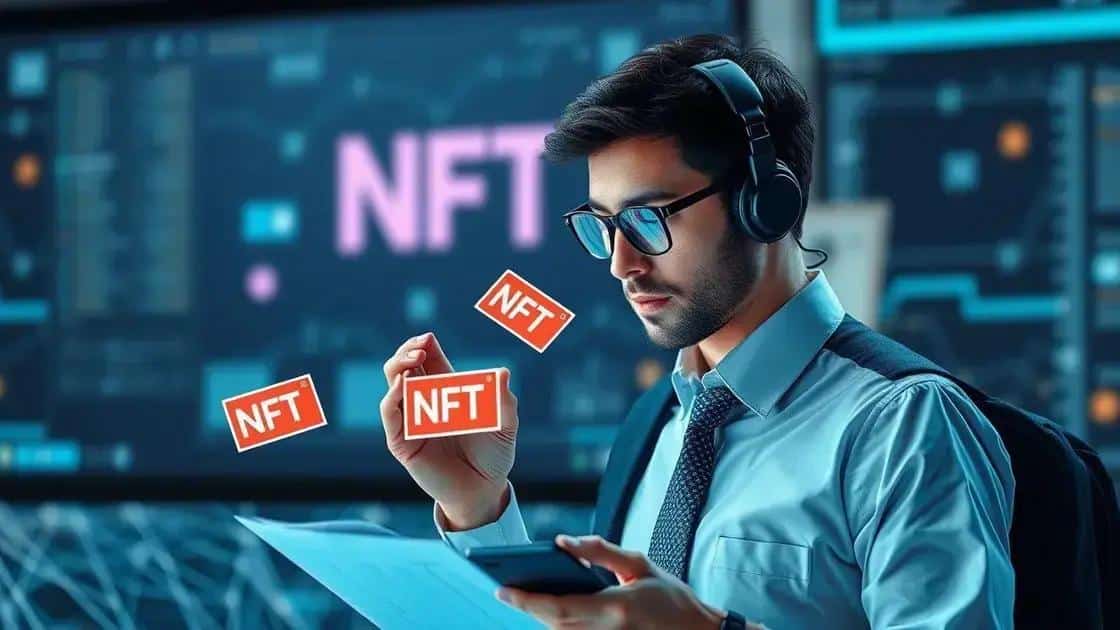NFT journalism: exploring the future of media

NFT journalism merges digital assets with media, allowing journalists to create unique, verifiable content while offering new monetization strategies and enhancing audience engagement.
NFT journalism is an emerging trend that intertwines digital assets with the media landscape. Have you ever wondered how this technology could change the way we consume news and art? Let’s dive into its intriguing possibilities.
Understanding NFT journalism
Understanding NFT journalism is essential in today’s media landscape. As technology evolves, so do the methods of information dissemination. With the rise of NFTs (Non-Fungible Tokens), traditional journalism is experiencing significant changes.
At its core, NFT journalism merges the digital world with journalistic practices. This connection creates unique opportunities for content creators to engage with audiences in novel ways. How does this impact the value and distribution of news? Let’s explore deeper.
The basics of NFTs
NFTs are unique digital assets verified using blockchain technology. This ensures their authenticity and ownership. Unlike cryptocurrencies, which are identical and interchangeable, NFTs represent individual items. This characteristic makes them suitable for various content types, including journalism.
Implications for journalists
- Ownership rights: Journalists can retain ownership of their works, ensuring recognition and revenue.
- Monetization: By selling their work as NFTs, journalists can create new income streams.
- Engagement: NFTs allow journalists to build a direct relationship with their audience.
- Decentralization: With NFTs, power shifts from traditional media companies to individual creators.
Furthermore, NFT journalism challenges the way audiences perceive media credibility. When journalists tokenize their stories, it introduces a new layer of transparency. Readers can trace the source and verify the content more easily. This shift could lead to stronger trust in journalists and their work.
As we look towards the future, NFT journalism may redefine standards in the industry. The blending of digital ownership with news content prompts essential discussions about ethics and the role of technology in journalism.
To summarize, understanding NFT journalism opens up a realm of possibilities. As journalists embrace these changes, they can engage their audiences while exploring new business models. This evolution represents not just change but an exciting opportunity for innovative storytelling.
Impact of NFTs on media integrity

Impact of NFTs on media integrity is a vital topic to consider in our digital age. As NFTs become more integrated into journalism, they raise important questions about trust and authenticity.
One significant effect of NFTs on media integrity is their potential to enhance transparency. By using blockchain technology, NFTs allow audiences to trace the ownership and origin of a news story. This verifiability can empower consumers and help them discern credible information.
Benefits of using NFTs
Many benefits come with adopting NFTs in journalism. For starters, they can secure the rights of creators better than traditional methods. Journalists can tokenize their work effectively, preventing unauthorized reproductions. This enhances intellectual property protection and ensures creators receive proper credit. Moreover, NFTs can create new revenue streams, allowing journalists to profit directly from their content.
Challenges to consider
- Misuse of technology: While NFTs promote authenticity, they can also be exploited to spread misinformation.
- Environmental concerns: The energy consumption of blockchains can lead to increased carbon footprints, raising ethical concerns.
- Market volatility: The fluctuating value of NFTs may impact journalistic stability.
- Access disparities: Not all journalists have the resources to engage with NFT technology, potentially widening gaps in the industry.
As we embrace NFTs, it’s critical to maintain a focus on ethical journalism. The core principles of accuracy, fairness, and integrity should guide the integration of this technology. Engaging readers through NFTs must not come at the expense of truthfulness.
Ultimately, the impact of NFTs on media integrity can be profound. By prioritizing transparency and ethical practices, the journalism industry can leverage the power of this technology while maintaining trust with audiences. This balance is essential as we navigate the complexities of modern media.
Monetization strategies for journalists
Monetization strategies for journalists have evolved with the introduction of NFTs. As the media landscape changes, journalists must adapt to new methods of earning income. Understanding these strategies can help journalists maximize their value in an increasingly digital world.
One effective strategy is selling news content as NFTs. By tokenizing their articles, journalists can create unique digital assets that collectors may purchase. This allows them to retain ownership while generating revenue directly from their work. As a result, NFT sales can provide a new income stream.
Diverse monetization options
There are several monetization options that journalists can explore beyond NFTs. For example, subscription models have become popular in recent years. Media outlets can offer exclusive content to subscribers, enhancing reader loyalty while generating steady income. Additionally, crowdfunding platforms allow journalists to receive direct support from their audiences, making their work financially sustainable.
Leveraging social media and partnerships
- Social media platforms: Journalists can use social media to promote their content and attract followers. A larger audience can lead to increased advertising revenue.
- Collaborations: Partnering with brands can provide sponsorship opportunities. Journalists can work with companies to create sponsored content or marketing campaigns.
- Grants and fellowships: Many organizations offer funding for investigative journalism projects. Seeking out grants can help journalists finance their work and maintain independence.
- Workshops and consultancy: Experienced journalists can host workshops or provide consulting services. This can be a lucrative way to share knowledge and skills.
As journalists adopt these monetization strategies, it’s crucial to maintain ethical standards. Being transparent with audiences about these practices fosters trust. Balancing profitability and integrity is vital in this new landscape.
Ultimately, by embracing a mix of monetization strategies, journalists can secure their financial futures while continuing to deliver quality content. This adaptability ensures their skills remain relevant in a digital age, paving the way for innovative storytelling.
Future of journalism with NFTs

Future of journalism with NFTs is a subject filled with potential and ambition. As technology continues to advance, the integration of NFTs into journalism promises to reshape the industry in significant ways.
One major change is how journalists can approach storytelling. NFTs allow for interactive and immersive experiences, shifting away from traditional text-based articles. For instance, journalists can create multimedia content that includes videos, animations, and infographics as NFTs. This new form of storytelling captures audiences’ attention and provides greater context to the news.
Transforming audience engagement
NFTs also transform how journalists engage with their audiences. By leveraging these digital tokens, journalists can foster a sense of community among their readers. They can offer exclusive access or unique content to NFT holders. This creates a closer connection with their audience, making them feel invested in the content.
Challenges and considerations
- Ethical concerns: As NFTs gain traction, journalists must navigate the balance between innovation and ethical reporting.
- Accessibility: Not all journalists have the resources to create or sell NFTs. Addressing this disparity is crucial for fairness in the industry.
- Regulatory issues: The legal status of NFTs can impact how journalists use them, so staying informed about regulations is essential.
- Market instability: The NFT market can be volatile, posing financial risks for journalists relying on sales for income.
By focusing on integrity and transparency, journalists can embrace the benefits of NFTs while addressing potential risks. The future of journalism with NFTs offers exciting opportunities but requires careful consideration.
As the landscape evolves, journalists who adapt to these changes can position themselves as pioneers in a new era of media. By embracing NFTs and innovative storytelling techniques, they can redefine the very essence of journalism.
FAQ – Frequently Asked Questions about NFTs in Journalism
What are NFTs and how do they relate to journalism?
NFTs, or Non-Fungible Tokens, are unique digital assets stored on the blockchain. In journalism, they can represent ownership of articles, multimedia content, and exclusive storytelling.
How can journalists monetize their work using NFTs?
Journalists can sell their articles or multimedia content as NFTs, allowing them to retain ownership and potentially earn revenue directly from their creations.
What challenges do journalists face when using NFTs?
Challenges include ethical concerns, market volatility, and ensuring accessibility for all journalists. It’s important to balance innovation with integrity.
Can NFTs enhance audience engagement for journalists?
Yes, by offering unique content and exclusive experiences to NFT holders, journalists can create a stronger connection with their audience and enhance engagement.





